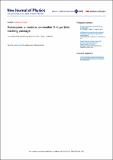Kassiopeia: a modern, extensible C++ particle tracking package
Author(s)
Groh, Stefan; Trost, Nikolaus; Babutzka, Martin; Barrett, John P; Behrens, Jan; Corona, Thomas; Enomoto, Sanshiro; Erhard, Moritz; Glück, Ferenc; Harms, Fabian; Heizmann, Florian; Hilk, Daniel; Käfer, Wolfgang; Kleesiek, Marco; Leiber, Benjamin; Mertens, Susanne; Renschler, Pascal; Schwarz, Johannes; Slocum, Penny L; Wandkowsky, Nancy; Wierman, Kevin; Zacher, Michael; Furse, Daniel Lawrence; Barrett, John Patrick; Buzinsky, Nicholas Gregory; Formaggio, Joseph A; Solomon-Oblath, Noah; ... Show more Show less
DownloadFurse_2017_New_J._Phys._19_053012.pdf (3.071Mb)
PUBLISHER_CC
Publisher with Creative Commons License
Creative Commons Attribution
Terms of use
Metadata
Show full item recordAbstract
The Kassiopeia particle tracking framework is an object-oriented software package using modern C++ techniques, written originally to meet the needs of the KATRIN collaboration. Kassiopeia features a new algorithmic paradigm for particle tracking simulations which targets experiments containing complex geometries and electromagnetic fields, with high priority put on calculation efficiency, customizability, extensibility, and ease-of-use for novice programmers. To solve Kassiopeia's target physics problem the software is capable of simulating particle trajectories governed by arbitrarily complex differential equations of motion, continuous physics processes that may in part be modeled as terms perturbing that equation of motion, stochastic processes that occur in flight such as bulk scattering and decay, and stochastic surface processes occurring at interfaces, including transmission and reflection effects. This entire set of computations takes place against the backdrop of a rich geometry package which serves a variety of roles, including initialization of electromagnetic field simulations and the support of state-dependent algorithm-swapping and behavioral changes as a particle's state evolves. Thanks to the very general approach taken by Kassiopeia it can be used by other experiments facing similar challenges when calculating particle trajectories in electromagnetic fields. It is publicly available at https://github.com/KATRIN-Experiment/Kassiopeia.
Date issued
2017-05Department
Haystack Observatory; Massachusetts Institute of Technology. Department of Physics; Massachusetts Institute of Technology. Laboratory for Nuclear ScienceJournal
New Journal of Physics
Publisher
IOP Publishing
Citation
Furse, Daniel, et al. “Kassiopeia: A Modern, Extensible C++ Particle Tracking Package.” New Journal of Physics, vol. 19, no. 5, May 2017, p. 053012. © 2017 IOP Publishing Ltd and Deutsche Physikalische Gesellschaft.
Version: Final published version
ISSN
1367-2630